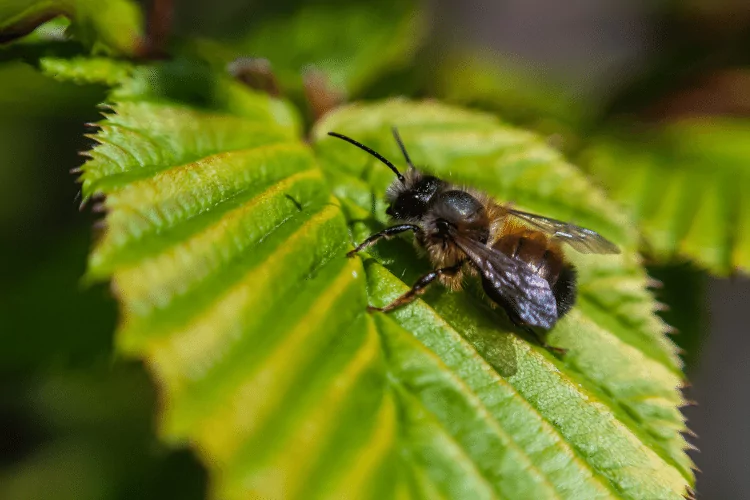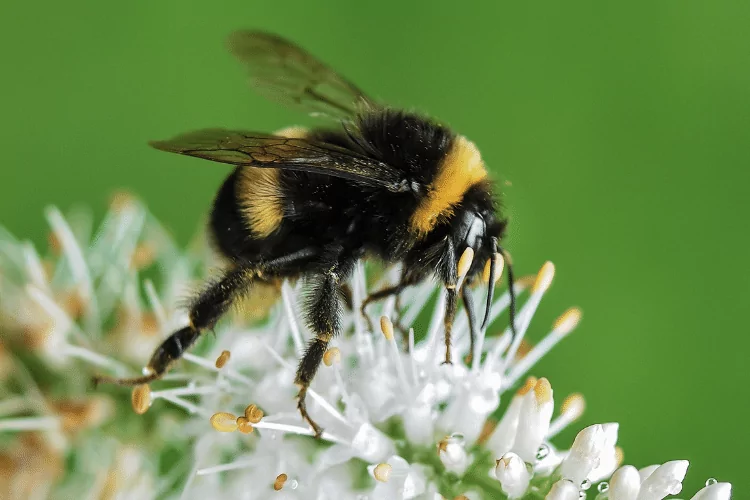Whether you’re into beekeeping or you have a garden that bees frequent, it’s important to know the different types of bees. Two of the most popular types you’ll come across are bumble bees and mason bees. So, what’s the difference between them?
Various distinctions set bumble bees apart from mason bees. For starters, bumble bees collect nectar, while mason bees only collect pollen. Additionally, bumble bees are much fuzzier than the iridescent mason bees.
In this article, we compared the excellent pollinators, bumble bee vs. mason bees, to help you decide which would be suitable for your garden. Let’s dive in!
Bumble Bee Overview
Bumble bees are one of the most popular bee species, especially in children’s drawings. There are over 250 species of these cute bugs.
As for their appearance, they’re somewhat larger than honeybees. Their most distinctive feature has to be their fuzz and colorful, striped tails.
In fact, you can barely see the bees’ small heads because of their fuzzy bodies and bright tails. They have dark bodies with yellow, orange, or red backs.
Bumble bees get their name from the bumbling sound they create when they’re inside the flowers. They move rather quickly. So, you might even see pollen stuck in their hair!
The bees form small colonies of only a few dozen bees. This means you’re unlikely to get a bumble bee infestation.
Moreover, the colony rarely stays in one place for long. If you find a bumble bee colony, avoid killing these cute bees, as their population is declining.
You can get incredibly close to bumble bees. They’re looking for pollen, not humans! However, if female bees sense danger, they might sting.
Raising Bumblebees
Bumble bees are incredibly beneficial insects. They’re also pretty easy to raise, even if you’re a beginner beekeeper. The bees are friendly and great for your flower garden.
These bees are the primary pollinators for a variety of flowers and vegetables. If you want to add mesmerizing color and sound to your garden, bumble bees would be the perfect choice.
You can easily catch a bumble bee queen. Next, add the queen to a proper container. Make sure your hive container is properly insulated to protect the bees from cold weather and environmental elements. Soon enough, you’ll have a thriving bee colony!
When you’re first starting your bumble bee colony, you might have to supply your bees with external food. After a week or two, the colony will be large enough for worker bees to forage for the nectar from flowers.
Mason Bee Overview
This type of bee is small and fast. Mason bees are the easiest to recognize due to their distinct metallic colors and iridescent shine. Their colors include dull green, blue, and black.

These bees are productive pollinators. That’s because they carry pollen on their underbelly hair. Then, the pollen drops to other plant species as they fly.
Mason bees rarely sting. The males don’t even have stingers. Female mason bees can sting only if handled roughly or if you trap them. However, they’re the most docile of bees.
As their name suggests, mason bees build their nests out of mud. They might also make a home out of an abandoned bee nest!
So, if you want to get rid of them, just avoid having dry patches of soil that they can use as a home. Instead, keep your garden moist, and cover any bare spots with mulch.
Raising Mason Bees
It might surprise you to find out that mason bees don’t live in hives. Instead, they make special tunnels in wood.
Mason bees are solitary. They don’t live in colonies, nor do they rely on a queen bee.
Accordingly, you can lure these bees by creating a bee hotel out of some hollow stems. If you want to make things easier, you can simply buy the bees!
Mason bees are the perfect addition to your garden. That’s because they’re efficient pollinators while still being low maintenance.
You can leave the bees to do their own thing. All you have to do is occasionally harvest the bee cocoons, store them, then release them in the spring.
Differences Between Bumblebees vs. Mason Bees
Now that you have all the basics about bumble bees and mason bees. Some key differences separate the two bee types. Understanding these distinctions will help you ultimately decide on which bees to keep.

Appearance
Bumble bees and mason bees couldn’t be more different. For starters, mason bees are dark. Some people might even mistake them for flies from afar.
On the other hand, bumble bees have dense hair and yellow and black stripes. They’re basically tiny, flying fuzz-balls!
Typically, bumble bees are larger than mason bees. They’re about ½ an inch to an inch long, while the largest mason bee doesn’t exceed ½ an inch.
If you’re looking to add bees to your garden for an extra flair, then you can’t go wrong with bumble bees.
Behavioral Characteristics
Both bumble bees and mason bees are friendly guests in your garden. They won’t harm any plants, they’re not territorial, and they rarely sting.
The main problem you might have with the two bee species is that their males can dispute with each other around the nest. That said, you can easily overcome this issue by providing a large enough home.
You don’t need to plant certain types of plants for either bee. They forage on all sorts of flowers and vegetables.
Honey Production
If you’re looking to collect honey from your bees, neither bumble bees nor mason bees would be suitable. Instead, people tend to keep these bees for pollination purposes.
While bumble bees collect nectar, they don’t convert the nectar into honey. As for mason bees, they don’t collect nectar! They only care about flowers for their pollen.
Conclusion
The differences between bumble bee vs. mason bee are plenty. Though the two species are ideal pollinators for your garden, their housing, and care are completely distinct.
To start, mason bees are solitary. They can even make their colony out of mud, or move into old bee colonies. In contrast, bumble bees follow their queen, making a nest wherever she is.
Whether you go for mason bees or bumble bees, the insects will definitely make your garden bloom. However, don’t expect to get honey from these pollinators!
- Does Bleach Kill Bees? - April 23, 2024
- How Do I Get Rid of Ants Without Harming Bees? - April 16, 2024
- Do Bug Zappers Kill Bees? Completely Explained - April 9, 2024
